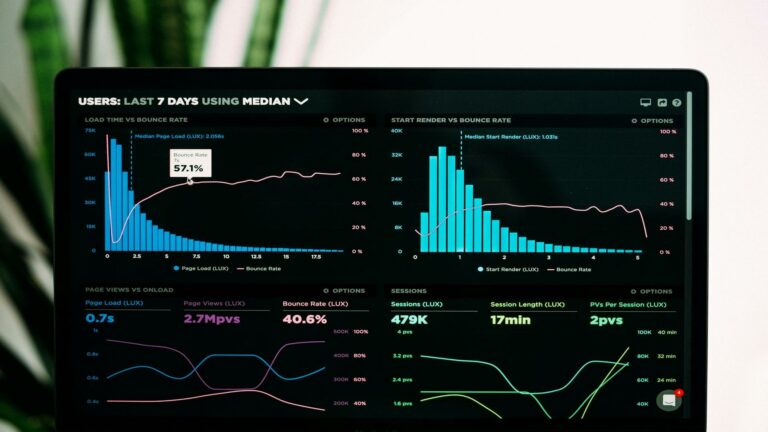Optimize Website Load Order: The Ultimate Guide to Faster Websites
Optimizing Website Load Order for Peak Performance
In today’s fast-paced digital world, website speed is crucial for user experience and search engine rankings. One of the most effective ways to improve your site’s performance is to optimize website load order. At Web Design London, we specialize in creating lightning-fast websites that not only look great but also perform exceptionally well. In this comprehensive guide, we’ll explore the importance of optimizing your website’s load order and provide you with actionable strategies to boost your site’s speed and efficiency.
Understanding the critical rendering path is essential when optimizing your website’s load order. This process involves the minimum steps a browser must take before rendering the first pixel on the screen. By prioritizing the loading of critical resources, you can significantly improve your site’s perceived load time and overall user experience.
Key Strategies for Optimizing Website Load Order:
- Prioritize Critical Rendering Files: Load essential CSS and JavaScript files early in the
<head>tag to ensure faster rendering. Consider using HTTP preload and server push techniques for critical resources. - Load Files in the Correct Sequence: Place external CSS before JavaScript in the
<head>tag, and load non-critical JavaScript at the bottom of the<body>tag to prevent render-blocking. - Implement Asynchronous Loading: Use asynchronous loading for CSS and JavaScript files to allow multiple files to load simultaneously, improving overall page performance.
- Optimize Images and Media: Compress and optimize images, and consider implementing lazy loading for non-critical media to reduce initial load times.
- Leverage Browser Caching: Utilize caching techniques to store static resources locally on users’ devices, reducing server requests and improving load times for returning visitors.
By implementing these strategies and continuously monitoring your website’s performance, you can ensure that your site loads quickly and efficiently, providing an optimal user experience and improving your search engine rankings. Remember, optimizing your website’s load order is an ongoing process that requires regular attention and fine-tuning to maintain peak performance in an ever-evolving digital landscape.
Why Optimizing Website Load Order Matters
The Importance of Optimizing Website Load Order
Optimizing your website’s load order is a critical aspect of web performance that can significantly impact user experience and business outcomes. Let’s explore why it’s crucial to prioritize this optimization:
- Improved User Experience: Faster loading times lead to happier visitors and lower bounce rates. When pages load quickly, users are more likely to stay engaged and explore your content. According to a study by Google, as page load time increases from 1 to 3 seconds, the probability of bounce increases by 32%.
- Better Search Engine Rankings: Google considers page speed as a ranking factor, giving faster sites an edge in search results. By optimizing your website’s load order, you can improve your chances of ranking higher in search engine results pages (SERPs), potentially driving more organic traffic to your site.
- Increased Conversion Rates: Quicker load times can significantly boost your conversion rates and sales. Research has shown that even a one-second delay in page load time can result in a 7% reduction in conversions. By prioritizing critical content and optimizing load order, you can ensure that users see the most important elements first, encouraging them to take desired actions.
- Enhanced Mobile Performance: Optimized load order is especially crucial for mobile users with slower connections. With the increasing prevalence of mobile browsing, ensuring your site loads quickly on smartphones and tablets is essential. Prioritizing content loading can help mobile users access key information faster, even on slower networks.
- Reduced Server Load: By optimizing the load order and minimizing unnecessary requests, you can reduce the strain on your server resources. This can lead to improved overall site performance and potentially lower hosting costs.
- Competitive Advantage: In today’s fast-paced digital landscape, users expect near-instant loading times. By optimizing your website’s load order, you can gain a competitive edge over slower-loading competitors, potentially capturing more market share in your industry.
Understanding these benefits highlights the importance of implementing effective strategies to optimize your website’s load order. In the following sections, we’ll explore practical techniques to achieve this optimization and improve your site’s overall performance.
7 Powerful Techniques to Optimize Website Load Order
Optimizing Website Load Order for Peak Performance
Optimizing your website’s load order is crucial for enhancing user experience and improving overall site performance. Let’s explore the most effective strategies to streamline your website’s loading process and boost its speed:
1. Prioritize Above-the-Fold Content
Focus on loading content that appears in the initial viewport first. This technique, known as above-the-fold optimization, ensures that users see the most important content quickly, improving perceived load times.
2. Implement Lazy Loading
Utilize lazy loading for images and videos that are not immediately visible to the user. This technique defers the loading of non-critical resources, significantly reducing initial page load times and conserving bandwidth.
3. Minify and Combine CSS and JavaScript
Reduce file sizes by minifying your CSS and JavaScript files. Additionally, consider combining multiple files to minimize HTTP requests. This approach can dramatically improve load times by reducing the overall payload size.
4. Leverage Browser Caching
Implement browser caching to store static resources locally on the user’s device. This technique allows returning visitors to load your site more quickly by retrieving cached resources instead of downloading them again.
5. Optimize Critical Rendering Path
Identify and optimize the critical rendering path to ensure that essential content renders as quickly as possible. This involves prioritizing the loading of critical CSS and deferring non-essential scripts.
6. Use a Content Delivery Network (CDN)
Implement a CDN to distribute your content across multiple servers worldwide. This reduces latency and improves load times for users accessing your site from various geographical locations.
By implementing these strategies, you can significantly optimize your website’s load order, resulting in faster page loads, improved user experience, and potentially better search engine rankings.
Measuring the Impact of Load Order Optimization
Measuring the Impact of Website Load Order Optimization
After implementing strategies to optimize website load order, it’s crucial to measure their impact. This process helps ensure that your efforts are yielding tangible improvements in user experience and search engine rankings. Let’s explore some key metrics and tools that can help you evaluate your website’s performance:
Essential Performance Metrics
- Page Load Time: The total time it takes for a page to fully load, which directly impacts user satisfaction and bounce rates.
- Time to First Byte (TTFB): This measures how long it takes for the browser to receive the first byte of data from the server, indicating server responsiveness.
- First Contentful Paint (FCP): The time it takes for the first content to appear on the screen, giving users the perception that the page is loading.
- Largest Contentful Paint (LCP): This metric tracks the time it takes for the largest content element to become visible, which is crucial for perceived load speed.
- Cumulative Layout Shift (CLS): A measure of visual stability during page load, ensuring elements don’t unexpectedly shift, which can frustrate users.
Tools for Performance Measurement
To effectively track these metrics and gain insights into your website’s performance, consider using the following tools:
- Google PageSpeed Insights: Offers both mobile and desktop performance scores along with optimization suggestions.
- GTmetrix: Provides detailed performance reports and recommendations for improvement.
- WebPageTest: Allows for testing from multiple locations and devices, offering in-depth performance analysis.
- Chrome DevTools: Built into the Chrome browser, it offers real-time performance monitoring and debugging capabilities.
- Lighthouse: An open-source tool that audits performance, accessibility, and more.
Regularly using these tools to monitor your website’s performance can help you identify areas for improvement and track the success of your optimization efforts. For example, you might discover that implementing lazy loading for images significantly improves your LCP score.
Remember, optimizing website load order is an ongoing process. As web technologies evolve and user expectations change, it’s important to stay proactive in your optimization efforts. By consistently measuring and refining your website’s performance, you can ensure it remains fast, responsive, and user-friendly, ultimately contributing to better search engine rankings and improved user engagement.
The Web Design London Approach to Load Order Optimization
Optimizing Website Load Order: A Comprehensive Approach
At Web Design London, we understand that optimizing website load order is crucial for enhancing user experience and improving search engine rankings. Our comprehensive approach ensures your website performs at its best:
- Initial Assessment: We begin with a thorough analysis of your current website performance, using tools like Google Lighthouse to identify bottlenecks and areas for improvement.
- Custom Optimization Strategy: Based on our findings, we develop a tailored plan that addresses your specific needs, focusing on critical aspects such as minimizing render-blocking resources and prioritizing above-the-fold content.
- Implementation: Our expert developers implement optimization strategies, including:
- Optimizing the critical rendering path
- Implementing lazy loading for images and videos
- Minifying and compressing CSS, JavaScript, and HTML
- Leveraging browser caching and Content Delivery Networks (CDNs)
- Continuous Monitoring: We use advanced tools to track your website’s performance over time, ensuring sustained improvements in load times and user engagement.
- Regular Updates: As web technologies evolve, we keep your website up-to-date with the latest optimization techniques and best practices.
By partnering with Web Design London, you’re investing in a long-term relationship with a team committed to maintaining your website’s optimal performance. We continuously refine your site’s load order to ensure it stays ahead of competitors and delivers an exceptional user experience.
Conclusion: The Power of Optimized Website Load Order
Optimizing Website Load Order: A Key to Digital Success
In today’s competitive digital landscape, optimizing your website’s load order is no longer optional—it’s essential. By implementing strategic load order optimization techniques, you can significantly improve your website’s speed, user experience, and search engine rankings.
Here are some key strategies to optimize your website’s load order:
- Prioritize critical content: Ensure that essential content loads first, allowing users to interact with your site quickly. Prioritizing content can dramatically improve perceived load times.
- Leverage browser caching: Utilize caching techniques to store static resources locally, reducing server requests and speeding up subsequent page loads.
- Optimize images and media: Compress and optimize your images to reduce file sizes without compromising quality, ensuring faster load times.
- Minimize HTTP requests: Reduce the number of elements that need to be loaded by combining files and using CSS sprites.
- Implement lazy loading: Delay the loading of non-critical resources until they’re needed, improving initial page load speed.
At Web Design London, we’re passionate about creating websites that not only look great but also perform exceptionally well. Our team of experts is ready to help you optimize your website’s load order and unlock its full potential.
By focusing on these optimization strategies, you can ensure that your website loads efficiently, providing a seamless user experience and improving your overall online presence. Remember, a faster website not only pleases your visitors but also contributes to better search engine rankings.
Ready to take your website’s performance to the next level? Contact Web Design London today for a free consultation and discover how we can help you optimize your website load order for unparalleled success in the digital realm.













